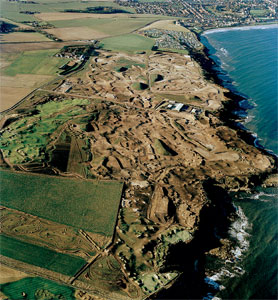A cut above
What does it take to design a modern classic? Kingsbarns architect, Kyle Phillips joins a number of fellow high-profile course designers to provide an insight into creating the ultimate challenge.

What does it take to design a modern classic? Kingsbarns architect, Kyle Phillips joins a number of fellow high-profile course designers to provide an insight into creating the ultimate challenge. By Mark Alexander
For some the lure of golf is to try and break 80, for others it?s to hit the perfect wedge shot. For golf course architects, it?s about creating the ultimate challenge. With a brief to build layouts that are sculpted yet demanding, course designers are a rare breed. Their tools include the sand trap, the water hazard, the dogleg and the two-tier green. And if the game wasn?t hard enough, they try to perplex us with blind tee shots and sloping fairways. To achieve this level of mischievous intent takes years of practice and dedication.
Kyle Phillips, designer of the celebrated Kingsbarns course near St Andrews in Fife and one of Hertfordshire?s finest tracks The Grove, spent most of his school years nursing bruised knuckles. ?I always had an interest in designing things,? he says. ?When I was 12, instead of taking notes I drew golf holes and houses. I remember getting my knuckles wrapped more than once by a passing teacher.?
MAN WITH A PLAN
After graduating from Kansas State University in America with a degree in landscape architecture, Phillips served a 16-year apprenticeship with Robert Trent Jones and sons before setting up his own practice in 1997 in California.
Today, his juvenile scribblings have been swapped for detailed plans of multi-million dollar developments.
?A good plan sets the stage for what you will do afterwards. The planning aspect is very important ? it gives you the opportunity to really set the foundations for what you?re going to do golf-wise,? says Phillips.
Get the Golf Monthly Newsletter
Subscribe to the Golf Monthly newsletter to stay up to date with all the latest tour news, equipment news, reviews, head-to-heads and buyer’s guides from our team of experienced experts.
With an average course taking nearly three years to design and build, it pays to think ahead. Building a layout is a huge undertaking, but getting it accepted as a classic is an entirely different challenge. The transition from ?new kid on the block? to a ?must-play? course is a difficult process that some venues are seeking to ease through tournament accreditation. In Wales, for example, Machynys Peninsula hosted the Wales Ladies Championship of Europe just three months after it was completed, and in Ireland the Palmerstown House PGA National was the venue for the Irish Professional Championship six months after its launch.
?I always had an interest in designing things. When I was 12, instead of taking notes I drew golf holes"
Bob Hunt, managing director of PGA Design Consulting, says 35 years of building courses have taught him that costs and expectations have to be dealt with early on.
?I?ve sat on many conference stages listening to famous British golf course architects say they can build golf courses for £300,000, but the costs don?t include irrigation and drainage. We think you need to consider everything that?s involved in golf design and that?s why we spend a lot of time doing feasibility studies.?
Hunt?s creations indicate a willingness to accept projects that others would shy away from. Take the $50 million Bora Country Club in South Korea which was constructed in just 17 months. Work undertaken included removing 220m-high hills, crushing 27 million cubic metres of rock and transplanting 20,000 mature trees into nurseries during construction. It took three contractors and 334 pieces of earth-moving equipment working 24 hours a day to complete the job. While this level of manipulation is rare, it shows what can be achieved when the juggernaut of golf construction builds up a head of steam.
THE TRADITIONAL APPROACH
Design may be the cornerstone of a good golf course, but subtle alterations that can drastically improve the quality of the end result occur during construction. ?You can draw whatever you want on a plan,? says Paul Kimber of DMK Design, ?but the guys who are actually building [the course] make the decisions that bring the course together.?
He also believes in a more traditional approach: ?The old architects built golf courses with very little machinery. Over the years, the machinery got bigger and the courses got boring. So we?re trying to recreate how it used to be done. We want to get more subtle shapes that you don?t get with a three-metre bulldozer blade. It?s about finding the right tool for the job.?
Presently working on the latest addition to St Andrews Links Trust?s portfolio, (course number 7, pictured) Kimber claims completion time is dependent on weather and soil, rather than technology. ?The length of the construction phase totally depends on the soil type, whether it?s rock or dirt, or how good the soil is. It is also determined by the length of the working season. At St Andrews, we get six months,? he says.
Using excavators with 22in buckets to fine-tune contours, the Essex-based company is one of a number of architectural firms reverting to more classical methods of construction. Among them is Phillips? practice. ?In the last 10 years, there?s been a group of people who have tried to create new courses with a traditional feel,? says the American. ?We?re interested in creating natural-looking golf courses that incorporate a lot of the contours that you used to find in golf.?
Phillips has been praised for his approach, yet he finds working in his homeland difficult. ?You still have the American-style designers who are creating flat fairways with perimeter moundings. The American view is that there should be a bunker at the landing area, a lake and some trees. It?s a very sterile Holiday Inn experience.
It?s MacDonaldising golf,? he says.
Kimber sums up his own philosophy. ?We?re going back 100 years, getting more ragged, tying to rough up the edges, rather than getting a smooth, polished finish. We?re trying to make our courses look 100 years old from day one. People talk about golf not being fair. It?s not meant to be fair ? if it was you would play it on a bowling alley. Golf is about shot making ? overcoming the bad breaks and making the most of the good ones. It?s about getting some unpredictability back into your round,? he says.
But as well as trying to create beautiful courses, designers are increasingly aware of the march of the modern game. ?You get these big, young lads who can generate massive amounts of clubhead speed, but have absolutely no clue where the ball is going to go,? says Phillips.
"People talk about golf not being fair. It?s not meant to be fair ? if it was you would play it on a bowling alley."
Interestingly the modern pro also seems to be less straight from the tee. European Tour statistics reveal that while the biggest hitters are comfortably driving 300+ yards, accuracy is suffering. Richard Green was the most accurate player on tour in 2000 with a driving accuracy of 79.5%. In 2005, his fellow Australian Peter O?Malley secured the same honour with 7% fewer fairway hits. If the pros are starting to spray, it?s a safe bet that we?re doing the same.
?Most courses need five sets of tees, which means you need a lot more room, especially as your average golfer is hitting the ball 250 yards and it?s going a lot wider,?
says Kimber. ?Tight golf is no fun either. We?d rather a course is set up so that if you?re in the wrong position, you don?t necessarily lose a ball, but you do have a difficult next shot. I?d prefer to see someone shoot 100 because they hit 100 shots, rather than losing four balls.?
SAFETY FACTORS
Longer and wider golf courses require more land, and that comes at a price, but there are alternatives, as Hunt explains. ?New club technology is adding significantly to the lengths of drives, so we are virtually compelled to create doglegs on most holes in order to force players to play for position ? we?re trying to make golfers think their way round the golf course and use most of the clubs in the bag. From a safety point of view, we?re seeing people with no handicap spraying balls all over the place. It is forcing us to set safety standards for the separation of fairways that are designed for the reasonable player, but you wonder if some people should be allowed to play at all.?
Willie Park Jnr once said, ?The laying out of a golf course is by no means a simple task.? He wasn?t wrong, although he didn?t have to contend with graphite shafts, titanium sweetspots and super-fit athletes. Despite claims wayward tee-shots are gaining even more latitude, many modern-day designers are returning to the contours of yesteryear to create natural-looking courses that may be a product of the modern era, but have their origins set in the past.
-
 Rory McIlroy Fires Back-To-Back 370-Yard Monster Drives In Birdie-Eagle-Birdie Start To Lead The Masters
Rory McIlroy Fires Back-To-Back 370-Yard Monster Drives In Birdie-Eagle-Birdie Start To Lead The MastersIt's safe to say that the four-time Major winner was full of adrenaline at the start of his third round, with McIlroy pounding two drives that measured a total of 740-yards
By Matt Cradock Published
-
 Who Is On Bryson DeChambeau’s Team? Coach, Caddie, Manager And More
Who Is On Bryson DeChambeau’s Team? Coach, Caddie, Manager And MoreBryson DeChambeau is one of the most high-profile and successful players of his era, but who are the team members helping to guide his career?
By Mike Hall Published